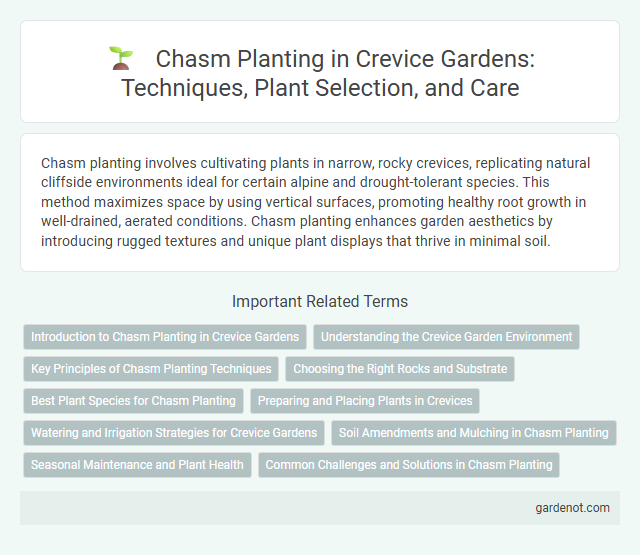Chasm planting involves cultivating plants in narrow, rocky crevices, replicating natural cliffside environments ideal for certain alpine and drought-tolerant species. This method maximizes space by using vertical surfaces, promoting healthy root growth in well-drained, aerated conditions. Chasm planting enhances garden aesthetics by introducing rugged textures and unique plant displays that thrive in minimal soil.
Introduction to Chasm Planting in Crevice Gardens
Chasm planting in crevice gardens involves cultivating plants in narrow, deep spaces between stones, mimicking natural rock fissures. This technique promotes excellent drainage and root aeration, ideal for alpine and drought-tolerant species. Crevice gardens enhance biodiversity by providing microhabitats that support specialized plants requiring minimal soil depth.
Understanding the Crevice Garden Environment
Chasm planting thrives in a crevice garden environment characterized by narrow, deep gaps between stones that mimic natural rock fissures. This unique setting provides excellent drainage, increased air circulation, and temperature fluctuations that promote robust root growth and stress tolerance in alpine plants. Understanding the interplay of sunlight exposure and moisture retention within these crevices is essential for optimizing plant health and biodiversity in crevice gardens.
Key Principles of Chasm Planting Techniques
Chasm planting techniques emphasize selecting drought-tolerant, deep-rooted plants that thrive in narrow, rocky crevices with minimal soil. Key principles include maximizing soil depth to ensure root anchorage, promoting water retention through organic mulch, and positioning plants to optimize light exposure while minimizing wind damage. Proper drainage is critical to prevent root rot, and careful spacing allows for natural growth and resilience in harsh crevice garden environments.
Choosing the Right Rocks and Substrate
Selecting angular, faulted rocks with natural fissures creates optimal crevices for chasm planting, promoting root stability and moisture retention. A well-draining substrate composed of gritty sand, decomposed granite, and organic matter mimics alpine conditions and supports delicate plant growth. Ensuring proper rock alignment and substrate depth is crucial for replicating natural microclimates favorable to specialized chasm flora.
Best Plant Species for Chasm Planting
Chasm planting thrives with species like Saxifraga, Heuchera, and Sedum due to their adaptability to narrow, rocky crevices and minimal soil. These plants exhibit high drought tolerance, shallow root systems, and the ability to withstand temperature fluctuations commonly found in crevice gardens. Incorporating alpine plants such as Dianthus and Phlox further enhances visual interest and resilience in chasm planting environments.
Preparing and Placing Plants in Crevices
Preparing and placing plants in crevices requires selecting species with shallow root systems and drought tolerance, such as sedums and saxifrages. Ensure the crevices are filled with well-draining, nutrient-rich soil or a specialized alpine mix to promote healthy root establishment. Position plants carefully to maximize exposure to sunlight and airflow, which helps prevent moisture retention and root rot in crevice gardens.
Watering and Irrigation Strategies for Crevice Gardens
Watering and irrigation strategies for crevice gardens emphasize efficient moisture management due to the deep, narrow gaps where plants grow. Drip irrigation systems are ideal, delivering water directly to the root zone within crevices, minimizing evaporation and runoff. Regular monitoring of soil moisture levels ensures plants receive adequate hydration without waterlogging, critical for the survival of chasmophytes adapted to rocky environments.
Soil Amendments and Mulching in Chasm Planting
Soil amendments in chasm planting improve drainage and nutrient retention by incorporating organic matter like compost or well-rotted manure, essential for deep, narrow crevices. Mulching with materials such as bark chips or gravel helps regulate soil moisture, prevent erosion, and suppress weed growth within the crevice environment. These practices optimize root health and promote sustainable growth in the unique microhabitats of crevice gardens.
Seasonal Maintenance and Plant Health
Seasonal maintenance in crevice gardens involves regular inspection of chasm plantings to remove dead foliage and prevent disease. Ensuring proper drainage and monitoring soil moisture levels supports the unique root structures of crevice plants, promoting overall health. Pruning and mulching during dormant seasons enhance growth cycles and protect plants from extreme weather conditions.
Common Challenges and Solutions in Chasm Planting
Chasm planting often faces challenges such as limited soil depth, poor moisture retention, and root space constraints, which can hinder plant growth and survival. Solutions include using specialized soil mixes with excellent drainage and moisture-holding properties, selecting drought-tolerant and shallow-rooted plants, and implementing regular irrigation to maintain adequate hydration. Proper maintenance involving periodic nutrient supplementation and removal of debris ensures healthy root development within the narrow crevices.
Chasm planting Infographic

 gardenot.com
gardenot.com